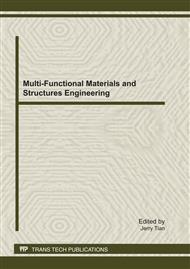p.107
p.115
p.119
p.124
p.131
p.135
p.142
p.148
p.154
Synthesis of High Strength and Well-Defined PEG-Based Hydrogel Networks via Click Chemistry
Abstract:
Click Chemistry was used to synthesize a series of PEG-based hydrogel networks. Attributable to the controlled nature and the quantitative yields of Click Chemistry, the prepared PEG-based hydrogels have the well-defined structures, which resulted in the improved mechanical properties and the high swelling ratios of hydrogels
Info:
Periodical:
Pages:
131-134
Citation:
Online since:
July 2011
Authors:
Price:
Сopyright:
© 2011 Trans Tech Publications Ltd. All Rights Reserved
Share:
Citation:


